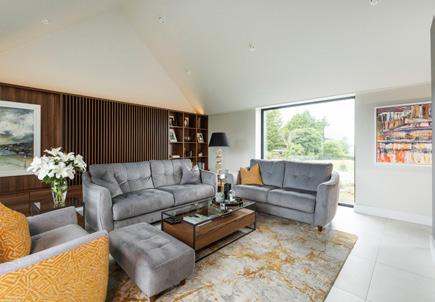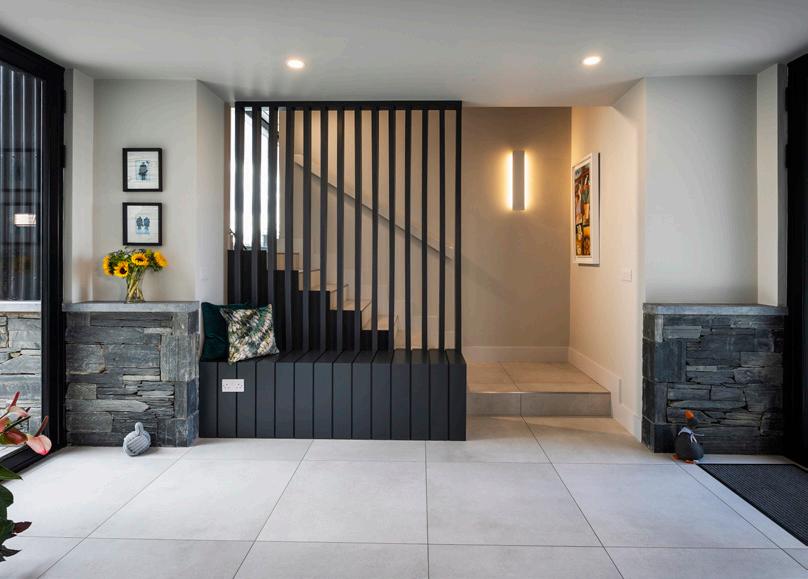
5 minute read
Q&A with Elaine & David
What is your favourite design feature?
Elaine: The brightness – my mum commented that you could never be depressed in this house because the extensive glazing allows in so much natural light.



What would you change or do differently?
David: We would have preferred not to have built during a pandemic. We were at roof levels when our business closed during the lockdown. It was quite scary.
What surprised you?
Elaine: The length of time it took from submitting the plans to turning the first sod. And the extra financial outlays that you have to pay on top of the building costs: surveyors, building control, planning, electrical and water fees, etc.
David: My brother, John, helped me open up the site with his digger. I bought two loads of stones, two gates and a couple of posts and I said to John “I’ve paid out £33k so far on this build, and this £200 spent on materials is the first bit I can actually touch”. Nobody tells you that when you start out.
What single piece of advice would you give a friend who’s looking to embark on a project similar to yours?
We’d recommend employing a quantity surveyor (QS) to manage the costs with your builder. It makes budgeting easier and a QS can tell you where you can save money. The cost of our QS was £8k, but he definitely saved us money.
Would you do it again?
David: Yes, I would do it again.
Elaine: I would do it again, but we won’t – we love this house.
be moved into the main body of the house. To do this we had to make the bedroom block a bit bigger on the ground floor.”
Building support
Following a visit to the Selfbuild Live event in Belfast, the Douglases decided to employ a quantity surveyor (QS). “This was one of the best things we did,” admits Elaine. “He produced the bill of quantities and organised the tendering process, which went out to several builders. We went with a fixed price contract with a builder from

Omagh who was already building some houses in the Banbridge area, so it suited them to build here.”
The QS produced a cost estimate which surprised Elaine and David. “It was quite a lot more than we had imagined it would be. We poured over it and changed a few things. We took out the polished concrete floor, for example, and made a few other adjustments. We had a budget that we had to stick to – there was no miraculous contingency pot we could dip into.”
The architect and QS continued to work with the builder throughout the build. “The team worked exceptionally well together,” says Elaine. “None of them had built a house of this style before, so there was some on the job learning regarding things like materials. The key to its success was constant communication between each party.”
“We were also actively involved in all the decision making on the design elements.”
As per Elaine’s wish list, the kitchen was at the heart of the house plans with the rest of the house radiating out from it.
The building is clad in black tin that covers a traditional, concrete block cavity wall filled with EPS insulation. “We initially had thought of using SIPs – structurally engineered panels – but having spoken to different builders, we concluded that, with the amount of glass we were putting into the house, we should use concrete blocks which would absorb some of the heat in the summertime.”


The building is made up of two, interconnecting blocks. A two storey bedroom block containing three ground floor ensuite bedrooms. A master suite is on the first floor along with a south facing sitting room that opens onto a roof terrace with views of the Mourne Mountains.



A single storey block contains the living and kitchen area, raised a metre from ground level to make the most of the views.
A separate building currently houses the couple’s home office and gym. It has been future proofed with services that will allow it to be used as separate living accommodations should circumstances change.
The pitched roofs are covered in tin cladding. “We were concerned at first that this would be very noisy on a wet day. Some people thought it might be akin to living in a caravan. But, in reality, there is very little sound, even during a heavy downpour. The roof is half a metre thick, made up of high grade tin with insulated backing to deaden the sound, and keep the heat in.”
Donegal slate complements the cladding. “At first, we did question Donal. Would it look too black and severe? He assured us otherwise, and he was absolutely correct. During the daylight, it never looks totally black. The sun softens it to a gentle grey which seems to disappear into the landscape. It looks far more discrete than the dazzling white rendered bungalows and two storey houses which you see everywhere.”
Elaine ’s tips
Be organised “I was a bit of an organisational freak,” says Elaine. “I bought all our ovens and fridges and had them sitting in the kitchen designer store for over a year. I was worried about Brexit – the manufacturer was German and I thought the prices would go up. The prices did go up, but because of shortages due to Covid lockdowns.”
Don’t sweat the small stuff. People get caught up in details like light switches. Initially, I picked one that cost £23 plus VAT. When our electrician added it all up, it was going to cost £4k for the whole house. He advised us to buy standard switches. We did and saved £3.5K.
Spend your money on the things you can’t change easily, like flooring. Light switches you can change at a later stage.
Ask for advice from your builder and ask him to be straight with you. We initially specified polished concrete throughout the house, but we decided not to go with it due to costs. When we told our builder this, he said that was a good idea because polished concrete has the potential to crack. We saved spending £35k on a floor that ultimately might have really disappointed us.
New Build
The house is heated by an air to water heat pump with underfloor heating throughout and a mechanical heat recovery system as well as solar PV panels. “It costs the same to heat our new house and offices (360sqm in total) as it did to heat our old 185sqm home,” says David.


Working backwards
Internally, the couple were adamant that there would be no wasted space. “We worked backwards, in that we stipulated at the design stage how we wanted the house to work for us,” says Elaine. “We didn’t want any formal rooms that would only be used on Christmas Day – we wanted to use all of our space, all the time.”

“I involved the kitchen designer right from the concept stage and made sure he had the architect’s contact details. The kitchen designer didn’t have to ring me to find out where the drains were, he could go straight to the architect.”
“I love cooking and we’re very sociable people. I wanted simplicity and straight lines in the kitchen and the kitchen designer got the concept right away.”
A floating wall separates the kitchen from the relaxed living area and includes storage cupboards along with the ovens. “Everybody who comes into our home sits up at the island. We’ve had lots of parties here and everything happens in the kitchen, just as I had envisioned it,” says Elaine.
Six years after her breast cancer diagnosis, Elaine is in remission and the house has fulfilled their expectations and more. “Part of the reason we did this project was to keep me going through some of the darker episodes of treatment,” says Elaine. “It’s been a beacon for us as a










